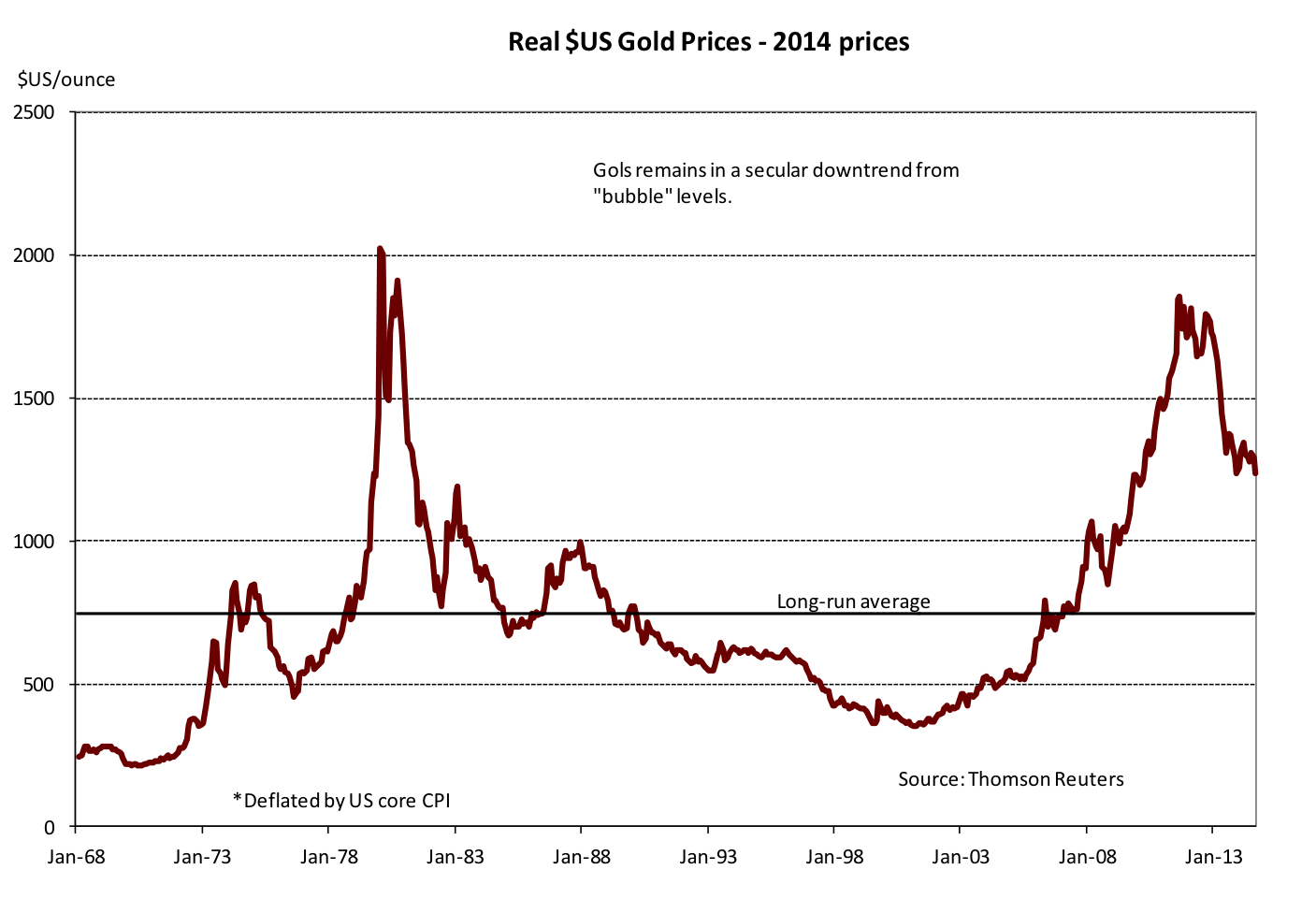Gold prices had a long a glorious run during the commodity price upswing and then during the early stages of global economic recovery from the 2008 financial crisis. But along with the commodity prices and the Australian dollar more broadly, gold prices peaked around mid-2011, and it has largely been one-way traffic downward ever since.
To be exact, the spot gold price has a closing high of $US1989/ounce in September 2011. It has since steadily declined, though has range-traded between $US1200 and $US1400 an ounce since mid-2013.
If you are still clinging to your gold investment on the view that central bank monetary stimulus will eventually produce an upsurge in inflation and gold prices, think again. And I’d also think again if you anticipate surging jewellery demand in China and India – or huge new buying from central banks – to save you.
To my mind, the range-trading over the past year has been only a temporary reprieve in what looks like a longer-term secular bear market for the precious metal. My message to you: get out while you still can.
Indeed, I suspect gold prices will soon break below their $US1200 support level, which will set us up for a move to below $US1000/ounce or more.
There are several reasons for my ongoing pessimism. For starters, the fact remains that monetary stimulus to date has not produce an upsurge in global inflation – largely because a continued spare economic capacity and the fact low interest rates have not spurred a strong upturn in business or consumer spending. With debt levels already high, and many scared by the financial crisis, global monetary policy has been in a classic liquidity trap – offering cheap money few want to use.
Secondly, gold prices had reached such heights that it naturally led to a downturn in underlying demand as related to jewellery and industrial uses. Even at $US1200, gold prices are still almost twice their long-run real level (i.e. since at least the early 1970s) after of $US750. Indian demand has been curtailed by gold import restrictions, while ongoing troubles in Middle East are also undermining an important source of demand.

As for investment demand, the self-reinforcing process that helped drive gold prices up are now slowly but surely heading into reverse. Strong gold demand – especially via new retail investor friendly financial products such as exchange traded funds (ETFs) helped push up prices during the bull run, which in turn encouraged even greater demand.
But with prices reaching historic highs and everyone that wanted to own gold already in the market, the process was doomed to eventually move into reverse. According to the World Gold Council, investment in gold holding through ETFs fell by 880 tonnes in 2013, though selling has slowed somewhat so far in 2014. But this selling is still only a fraction of the large run-up in holdings over the previous decade. Gold demand still appears imbalance, with an over reliance on investors still clinging to their holding.
The third key negative is the gathering strength in the US dollar, which historically tends to hurt gold prices – if only because it makes purchases by non-US investors more expensive. With the US economy in recovery mode and the Federal Reserve inching toward higher interest rates, the direction in the (still relatively cheap) US dollar seems clear.
Note that gold is also failing to offer much of a safe-haven in these troubled times – with the US dollar increasingly taking back that role. Bouts of global equity market weakness over the past year have not led to gold rebounds.
Of course, if you like gold for its longer-term diversification properties, that’s fine. It does, after all, offer a hedge against extreme tail risks such as an upsurge in inflation or wide geo-political crises. But if you were in the gold market looking as a speculative trade, don’t fall into the trap of now rationalising this as long-term “investment” in order to avoid accepting losses. And if you’re not in the market, I would warn against trying to bottom pick the market on the view that prices are now cheaper than they were. Don’t try to catch a falling knife. And as noted above, from a longer term perspective, gold is not yet that cheap in any case.







